south carolina
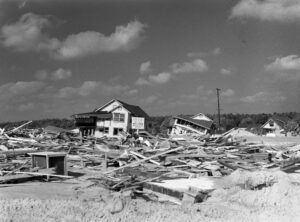
 When I think of a hurricane, I think of a tropical storm that escalates, and I suppose most of the time, that would be right, but it isn’t always the case. Sometimes hurricanes can develop in a more northern area, or as in the case of Hurricane Hazel on October 15, 1954 a strong hurricane somehow continues north as a hurricane after it hit first in a more southern area. Hurricane Hazel was a hurricane that struck the Carolina’s, and then and then moved into Ontario as a powerful extratropical storm…still of hurricane intensity, after that initial strike in the Carolinas.
When I think of a hurricane, I think of a tropical storm that escalates, and I suppose most of the time, that would be right, but it isn’t always the case. Sometimes hurricanes can develop in a more northern area, or as in the case of Hurricane Hazel on October 15, 1954 a strong hurricane somehow continues north as a hurricane after it hit first in a more southern area. Hurricane Hazel was a hurricane that struck the Carolina’s, and then and then moved into Ontario as a powerful extratropical storm…still of hurricane intensity, after that initial strike in the Carolinas.
The deadliest hurricane of the 1954 Atlantic hurricane season, Hurricane Hazel was also the second costliest, and the most intense hurricane of that year. The storm killed at least 469 people in Haiti before striking the United States as a Category 4 hurricane near the border between North and South Carolina. As Hazel ripped through Haiti, it destroyed 40% of the coffee trees and 50% of the cacao crop, which would drastically affected the economy for several years.
After causing 95 fatalities in the US, Hazel struck Canada as an extratropical storm, raising the death toll by 81 people, mostly in Toronto. When Hazel made landfall near Calabash, North Carolina, it destroyed most waterfront homes. Then as it screamed north along the Atlantic coast, Hazel affected Virginia, Washington DC, West Virginia, Maryland, Delaware, New Jersey, Pennsylvania, and New York; as it lashed the area with gusts near 100 miles per hour and caused $281 million, which today would be $2720 million in damage. When it was over Pennsylvania, Hazel consolidated with a cold front and turned northwest towards Canada.
In addition to the fatalities, Hurricane Hazel brought with it flash flooding in Canada, which destroyed twenty bridges, killed 81 people, and left over 2,000 families homeless in Canada alone. In all, and including the strike in the Carolinas, where Hazel killed 95 people and caused almost $630 million ($6,100 million today) in damages, on top of over 500 other deaths and billions in damage in the US and Caribbean. No other recent natural disaster on Canadian soil has been so deadly. Floods killed 35 people on a single street in Toronto.
When it hit Ontario as an extratropical storm, rivers and streams in and around Toronto overflowed their banks, which caused severe flooding. As a result, many residential areas in the local floodplains, such as the Raymore Drive area, were subsequently converted to parkland. In Canada alone, over C$135 million (C$1.3 billion, 2021) of damage was incurred. The effects of Hazel were particularly unprecedented in Toronto due to a combination of heavy rainfall during the preceding weeks, a lack of experience in dealing with tropical storms, 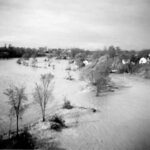
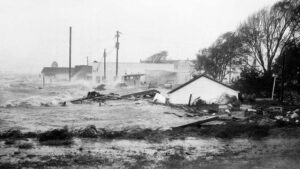 and the storm’s unexpected retention of power despite traveling 680 miles over land. The storm stalled over the Toronto area, and although it was now extratropical, it remained as powerful as a category 1 hurricane. To help with the cleanup, 800 members of the military were called in and a Hurricane Relief Fund was quickly established that distributed $5.1 million ($49.1 million today) in aid. The name Hazel was retired as a named storm, because of the high death toll.
and the storm’s unexpected retention of power despite traveling 680 miles over land. The storm stalled over the Toronto area, and although it was now extratropical, it remained as powerful as a category 1 hurricane. To help with the cleanup, 800 members of the military were called in and a Hurricane Relief Fund was quickly established that distributed $5.1 million ($49.1 million today) in aid. The name Hazel was retired as a named storm, because of the high death toll.
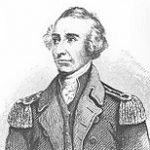 As with any war, there are opinions that are polar opposites from each other. After all, if they all agreed, there would be no need for war. The Revolutionary War was no different. Yes, the British wanted to keep the United States as colonies belonging to the crown, but the people of the United States would have none of it…well, most of the people anyway. It seems shocking to us now, to think that there would be people in the United States who would want us to remain under Britain’s rule, but in fact, there were. They were known as the Loyalists, and they set about doing whatever they could to cause the United States to lose the Revolutionary War.
As with any war, there are opinions that are polar opposites from each other. After all, if they all agreed, there would be no need for war. The Revolutionary War was no different. Yes, the British wanted to keep the United States as colonies belonging to the crown, but the people of the United States would have none of it…well, most of the people anyway. It seems shocking to us now, to think that there would be people in the United States who would want us to remain under Britain’s rule, but in fact, there were. They were known as the Loyalists, and they set about doing whatever they could to cause the United States to lose the Revolutionary War.
Patriot, Lieutenant Colonel Francis “The Swamp Fox” Marion was fresh from a victory at Nelson’s Ferry on the Santee River in South Carolina on August 20, 1780. Marion, who was just five feet tall, won fame and the “Swamp Fox” nickname for his ability to strike and then quickly retreat into the South Carolina swamps without a trace. Marion used irregular methods of warfare and is considered  one of the fathers of modern guerrilla warfare and maneuver warfare, and is credited in the lineage of the United States Army Rangers. After the victory at Nelson’s Ferry, Marion and 52 of his militiamen rode east in order to escape the pursuing British Loyalists. They were successful, but during their escape, a second and much larger, force of Loyalists led by Major Micajah Ganey, attacked the militia from the northeast. Marion’s advance guard, led by Major John James, defeated Ganey’s advance guard and Marion ambushed the rest, causing Ganey’s main body of 200 Loyalists to flee in panic. The success of Marion’s militia broke the Loyalist stronghold on South Carolina east of the PeeDee River and attracted another 60 volunteers to the Patriot cause.
one of the fathers of modern guerrilla warfare and maneuver warfare, and is credited in the lineage of the United States Army Rangers. After the victory at Nelson’s Ferry, Marion and 52 of his militiamen rode east in order to escape the pursuing British Loyalists. They were successful, but during their escape, a second and much larger, force of Loyalists led by Major Micajah Ganey, attacked the militia from the northeast. Marion’s advance guard, led by Major John James, defeated Ganey’s advance guard and Marion ambushed the rest, causing Ganey’s main body of 200 Loyalists to flee in panic. The success of Marion’s militia broke the Loyalist stronghold on South Carolina east of the PeeDee River and attracted another 60 volunteers to the Patriot cause.
Marion rarely committed his men to frontal warfare, which was much more risky, but repeatedly surprised larger bodies of Loyalists or British regulars with quick surprise attacks and equally quick withdrawal from the 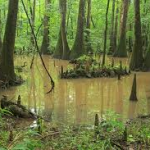 field. He was considered almost a ghost. Marion had previously earned fame as the only senior Continental officer in the area to escape the British following the fall of Charleston on May 12, 1780. His military strategy, while odd for the time, was really advanced for the time, and similar to some of today’s strategies. Marion took over the South Carolina militia force, first assembled by Thomas Sumter in 1780. Sumter returned home to bring Carolina Loyalists’ style terror tactics on the Loyalists who burned his plantation. After being wounded, Sumter withdrew from active fighting. Marion replaced him and teamed up with Major General Nathaniel Greene, who arrived in the Carolinas to lead the Continental forces in October 1780. Together, they are credited with pulling a Patriot victory from the jaws of defeat in the southern states.
field. He was considered almost a ghost. Marion had previously earned fame as the only senior Continental officer in the area to escape the British following the fall of Charleston on May 12, 1780. His military strategy, while odd for the time, was really advanced for the time, and similar to some of today’s strategies. Marion took over the South Carolina militia force, first assembled by Thomas Sumter in 1780. Sumter returned home to bring Carolina Loyalists’ style terror tactics on the Loyalists who burned his plantation. After being wounded, Sumter withdrew from active fighting. Marion replaced him and teamed up with Major General Nathaniel Greene, who arrived in the Carolinas to lead the Continental forces in October 1780. Together, they are credited with pulling a Patriot victory from the jaws of defeat in the southern states.
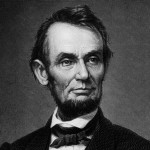 Hot air balloons have been around for a long time, and there have been multiple uses for them. Hot air balloons have been used for everything from travel, recreation, escape, war, and even spying. It was the latter reason that brought President Abraham Lincoln to a field outside Washington DC on October 4, 1861. Those were tumultuous years, with the Civil War in full swing, and both the Confederate and the Union armies were experimenting with the idea of using hot air balloons to gather military intelligence. It was probably a good idea, but there was enough danger involved with this idea, that it proved to be impractical in most situations.
Hot air balloons have been around for a long time, and there have been multiple uses for them. Hot air balloons have been used for everything from travel, recreation, escape, war, and even spying. It was the latter reason that brought President Abraham Lincoln to a field outside Washington DC on October 4, 1861. Those were tumultuous years, with the Civil War in full swing, and both the Confederate and the Union armies were experimenting with the idea of using hot air balloons to gather military intelligence. It was probably a good idea, but there was enough danger involved with this idea, that it proved to be impractical in most situations.
I don’t think most people who were presented with the idea of using hot air balloons in a war situation, were very sold on it. Several firms had been talking to the War Department about balloons, but Thaddeus SC Lowe, who had been working with hydrogen balloons for several 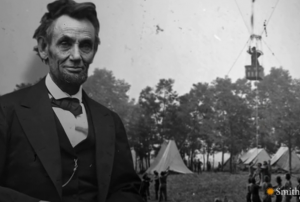 years, and was convinced that they could be a useful tool for collecting intelligence, was the primary figure in that quest. He had conducted trials in April 1861 near Cincinnati, Ohio, with the support of the Smithsonian Institution. On April 19, 1861, he took flight for a trip that would take him to Unionville, South Carolina, where he was immediately jailed by the Confederates, who were convinced that he was a Union spy.
years, and was convinced that they could be a useful tool for collecting intelligence, was the primary figure in that quest. He had conducted trials in April 1861 near Cincinnati, Ohio, with the support of the Smithsonian Institution. On April 19, 1861, he took flight for a trip that would take him to Unionville, South Carolina, where he was immediately jailed by the Confederates, who were convinced that he was a Union spy.
In the end, Lowe had it right. The hot air balloon could be instrumental in winning a war. He became the head of the Union’s Balloon Corpsin 1861 and served effectively during the Peninsular campaign of 1862. With the views provided from his balloon, Lowe discovered that the Confederates had evacuated Yorktown, Virginia, and 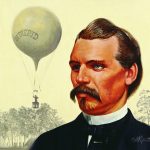 he provided important intelligence during the Battle of Fair Oaks, Virginia. He had a good working relationship with George McClellan, commander of the Army of the Potomac, but had difficulties with McClellan’s successors. Generals Ambrose Burnside and Joseph Hooker were sadly not convinced that balloon observations provided accurate information. I guess they just didn’t have the same vision as Lowe had. Lowe became increasingly frustrated with the army, particularly after his pay was slashed in 1863. Feeling that army commanders did not take his service seriously, Lowe resigned in the spring of 1863. The Balloon Corps was disbanded in August of that year. Lowe later became involved in building a railway in California. He died there in 1913 at age 80.
he provided important intelligence during the Battle of Fair Oaks, Virginia. He had a good working relationship with George McClellan, commander of the Army of the Potomac, but had difficulties with McClellan’s successors. Generals Ambrose Burnside and Joseph Hooker were sadly not convinced that balloon observations provided accurate information. I guess they just didn’t have the same vision as Lowe had. Lowe became increasingly frustrated with the army, particularly after his pay was slashed in 1863. Feeling that army commanders did not take his service seriously, Lowe resigned in the spring of 1863. The Balloon Corps was disbanded in August of that year. Lowe later became involved in building a railway in California. He died there in 1913 at age 80.
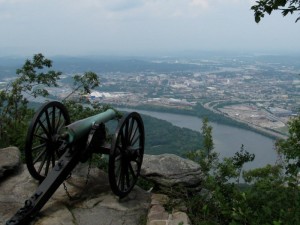
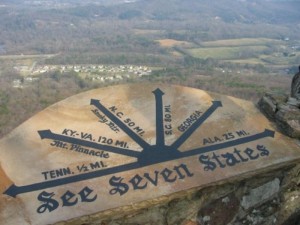 On a trip to Tennessee and the surrounding area in April of 2003, Bob and I had the opportunity to visit Lookout Mountain, which is located near Chattanooga, in southwestern Tennessee. The drive up was stunning, and everything we saw there from Ruby Falls, to the Incline Railway, and Rock City proved to hold amazing views as well. From the top of the mountain, you can see seven states…Tennessee, Kentucky, North Carolina, South Carolina, Virginia, Georgia, and Alabama. The view across that area is spectacular. When we travel, we love to go sight seeing, so this area fit right into our idea of a great place to visit. looking back now, I’m sure that time constraints played a part in my missing out on some of the amazing historical value of the area I was visiting, and to me, that is really a shame, because so much took place there, and I didn’t even know it.
On a trip to Tennessee and the surrounding area in April of 2003, Bob and I had the opportunity to visit Lookout Mountain, which is located near Chattanooga, in southwestern Tennessee. The drive up was stunning, and everything we saw there from Ruby Falls, to the Incline Railway, and Rock City proved to hold amazing views as well. From the top of the mountain, you can see seven states…Tennessee, Kentucky, North Carolina, South Carolina, Virginia, Georgia, and Alabama. The view across that area is spectacular. When we travel, we love to go sight seeing, so this area fit right into our idea of a great place to visit. looking back now, I’m sure that time constraints played a part in my missing out on some of the amazing historical value of the area I was visiting, and to me, that is really a shame, because so much took place there, and I didn’t even know it.
I suppose I should have known the history of the area, but apparently I wasn’t as up on my Civil War and Indian history as I am now. I really wish I had known or had at least taken more time reading the many signs in the area, because I could have figured out what a great area we were in. During the Nickajack Expedition which occurred in the 18th century, Lookout Mountain would become a last stand for the Chickamauga Cherokee, who were followers of Chief Dragging Canoe, who opposed the peace treaty between Native Americans and the American settlers. The peace treaty was signed in 1777. Most of the Chickamauga Cherokee agreed to the treaty, but a small band followed Chief Dragging Canoe, and they went to battle in the late summer through the fall of 1794. The final battle, and the point that Chief Dragging Canoe’s warriors would lose the fight took place on Lookout Mountain. The Indians were no match for the military might of the army, and after wounding only 3 of the militia, the villages of Nickajack Town and Running Water Town were destroyed, leaving seventy Cherokee dead.
The Civil War battle that made Lookout mountain famous took place on November 24, 1863 and was a part of the Chattanooga Campaign. Major General Joseph Hooker defeated the Confederate forces who were under the command of Major General Carter Stevenson. Lookout mountain has an excellent view of the Tennessee River, making it a perfect stronghold. It also held a perfect view of the Union supply lines, so if the Confederate army wanted to starve out the Union army, they needed Lookout Mountain, and if the Union army wanted to keep their supply lines clear, they needed Lookout Mountain. One of the hardest places to fight a battle is a mountain…at least for the side who is at the bottom of the mountain. They are far too visible to fight the battle easily. So, after calling for reinforcements, Major General Joseph Hooker went into battle. It was a must win situation. If they lost the Union soldiers would be starved into surrender.
Looking back now on our visit makes everything we saw seem much more interesting. In my memory files, I can pull out the different views of our visit to Lookout Mountain, and I can visualize the exact view the Confederate soldiers had, and knowing that there was virtually no place to hide, I can’t help but wonder how the Union soldiers managed to win that battle. I suppose that it was partly the numbers of soldiers, with 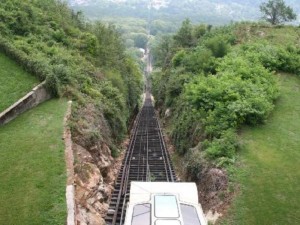
 the Union having more than 1,000 more, but more importantly, I think it was the fact that they surrounded the Confederate soldiers, leaving them with too many sides to cover. Our trip to Lookout Mountain, Ruby Falls, and Rock City has taken on a whole new meaning for me. I wish I had known it then. I would have really enjoyed that stroll through history. The great thing is that my pictures, memories, and a little look at history can take me back to visit again.
the Union having more than 1,000 more, but more importantly, I think it was the fact that they surrounded the Confederate soldiers, leaving them with too many sides to cover. Our trip to Lookout Mountain, Ruby Falls, and Rock City has taken on a whole new meaning for me. I wish I had known it then. I would have really enjoyed that stroll through history. The great thing is that my pictures, memories, and a little look at history can take me back to visit again.

